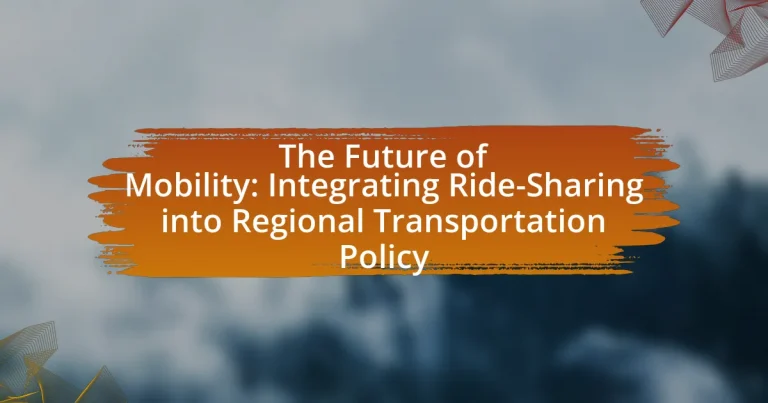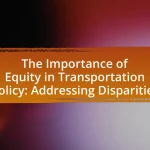The article focuses on the future of mobility, specifically the integration of ride-sharing into regional transportation policy. It outlines how ride-sharing services are evolving to become essential components of urban mobility ecosystems, driven by technological advancements and urbanization. Key topics include the definition of ride-sharing within transportation policy, its characteristics, differences from traditional transportation methods, and the importance of integrating ride-sharing to enhance urban mobility, reduce congestion, and lower emissions. The article also discusses challenges faced by urban mobility, the economic benefits of ride-sharing, regulatory considerations, and future trends such as the adoption of electric and autonomous vehicles.

What is the Future of Mobility in the Context of Ride-Sharing?
The future of mobility in the context of ride-sharing is characterized by increased integration with public transportation systems and advancements in technology. Ride-sharing platforms are expected to evolve into essential components of urban mobility ecosystems, facilitating seamless connections between various modes of transport. According to a report by McKinsey & Company, the ride-sharing market is projected to grow significantly, potentially reaching $285 billion by 2030, driven by urbanization and changing consumer preferences. This growth will likely lead to enhanced partnerships between ride-sharing companies and local governments, promoting policies that prioritize shared mobility solutions to reduce congestion and emissions.
How is ride-sharing defined within regional transportation policy?
Ride-sharing is defined within regional transportation policy as a transportation service that allows individuals to share a vehicle for a trip, typically facilitated through digital platforms. This definition encompasses various models, including peer-to-peer ride-sharing and ride-hailing services, which aim to reduce traffic congestion, lower transportation costs, and enhance mobility options. Regional transportation policies often incorporate ride-sharing to promote sustainable urban development and improve public transit integration, as evidenced by studies showing that cities implementing ride-sharing initiatives experience a decrease in single-occupancy vehicle trips and an increase in overall transportation efficiency.
What are the key characteristics of ride-sharing services?
Ride-sharing services are characterized by their use of mobile applications to connect passengers with drivers for on-demand transportation. These services typically operate on a peer-to-peer model, allowing individuals to offer rides in their personal vehicles, which enhances accessibility and convenience. Additionally, ride-sharing services often feature dynamic pricing, where fares fluctuate based on demand and supply conditions, providing economic efficiency. According to a 2020 study by the International Transport Forum, ride-sharing can reduce the number of vehicles on the road, thereby contributing to lower traffic congestion and emissions.
How does ride-sharing differ from traditional transportation methods?
Ride-sharing differs from traditional transportation methods primarily in its operational model, which connects passengers with drivers through a digital platform, allowing for on-demand services. Traditional transportation methods, such as taxis or public transit, typically operate on fixed routes and schedules, limiting flexibility for users. In contrast, ride-sharing services like Uber and Lyft utilize smartphone applications to facilitate real-time ride requests, enabling users to choose their pick-up and drop-off locations. This model has led to increased convenience and efficiency, as evidenced by a 2019 study from the University of California, Berkeley, which found that ride-sharing reduced the need for personal vehicle ownership in urban areas by 20%.
Why is integrating ride-sharing into transportation policy important?
Integrating ride-sharing into transportation policy is important because it enhances urban mobility, reduces traffic congestion, and lowers greenhouse gas emissions. Studies indicate that ride-sharing services can decrease the number of vehicles on the road; for instance, a report from the University of California, Berkeley, found that ride-sharing could reduce vehicle miles traveled by up to 10%. Additionally, incorporating ride-sharing into transportation policy can improve access to public transit, as evidenced by partnerships between ride-sharing companies and transit agencies that facilitate first-mile and last-mile connectivity. This integration supports sustainable urban development and aligns with goals for reducing reliance on single-occupancy vehicles.
What challenges does urban mobility face that ride-sharing can address?
Urban mobility faces challenges such as traffic congestion, limited parking availability, and high transportation costs, which ride-sharing can effectively address. Ride-sharing services reduce the number of vehicles on the road, thereby alleviating congestion; for instance, a study by the University of California, Berkeley, found that ride-sharing can decrease vehicle miles traveled by up to 30%. Additionally, ride-sharing platforms optimize routes, making transportation more efficient and reducing the need for extensive parking infrastructure. Furthermore, these services often provide a cost-effective alternative to car ownership, which can be particularly beneficial in urban areas where expenses related to owning a vehicle are high.
How can ride-sharing improve accessibility in transportation?
Ride-sharing can improve accessibility in transportation by providing on-demand services that connect users to various destinations, particularly in underserved areas. This model allows individuals without access to personal vehicles, such as those in low-income neighborhoods or with disabilities, to obtain reliable transportation options. According to a study by the National Academies of Sciences, Engineering, and Medicine, ride-sharing services can reduce transportation barriers by increasing mobility for populations that traditionally face challenges in accessing public transit. Additionally, ride-sharing platforms often offer features like wheelchair-accessible vehicles, further enhancing accessibility for individuals with mobility impairments.
What are the potential impacts of ride-sharing on regional transportation systems?
Ride-sharing significantly impacts regional transportation systems by reducing the reliance on personal vehicles, which can lead to decreased traffic congestion and lower greenhouse gas emissions. Studies indicate that cities with robust ride-sharing services experience a reduction in vehicle miles traveled; for instance, a report from the University of California, Berkeley, found that ride-sharing services contributed to a 10% decrease in personal vehicle trips in urban areas. Additionally, ride-sharing can enhance public transit accessibility by providing first-mile and last-mile solutions, thereby increasing overall ridership and efficiency of regional transit networks. This integration can lead to a more sustainable transportation ecosystem, as evidenced by cities like San Francisco, where ride-sharing has been incorporated into the broader transit strategy to improve mobility options for residents.
How does ride-sharing influence traffic congestion and emissions?
Ride-sharing reduces traffic congestion and emissions by decreasing the number of single-occupancy vehicles on the road. Studies indicate that ride-sharing services can lead to a reduction in vehicle miles traveled (VMT) by providing an alternative to personal car use. For instance, a study by the University of California, Berkeley, found that ride-sharing services like Uber and Lyft can reduce VMT by up to 10% in urban areas. Additionally, ride-sharing can lower greenhouse gas emissions by promoting carpooling, which maximizes vehicle occupancy. According to the International Council on Clean Transportation, ride-sharing can reduce emissions by approximately 30% per passenger mile compared to single-occupancy trips.
What economic benefits can arise from integrating ride-sharing?
Integrating ride-sharing can lead to significant economic benefits, including reduced transportation costs for consumers and increased income opportunities for drivers. Studies indicate that ride-sharing services can lower personal transportation expenses by up to 30%, making mobility more affordable. Additionally, the ride-sharing industry has created millions of jobs; for instance, a report from the Rideshare Guy estimates that over 1.5 million drivers in the U.S. earn supplementary income through these platforms. Furthermore, ride-sharing can decrease congestion and improve urban mobility, which can enhance productivity and economic output in cities. According to a study by the University of California, Berkeley, integrating ride-sharing with public transit can lead to a 10% increase in public transit ridership, further stimulating local economies.

How can ride-sharing be effectively integrated into regional transportation policy?
Ride-sharing can be effectively integrated into regional transportation policy by establishing regulatory frameworks that promote collaboration between ride-sharing companies and local governments. This integration can be achieved through policies that incentivize ride-sharing services to operate in underserved areas, thereby enhancing accessibility and reducing congestion. For instance, cities like San Francisco have implemented partnerships with ride-sharing platforms to provide first-mile and last-mile solutions, which complement public transit systems. Additionally, data-sharing agreements can be established to allow regional planners to analyze usage patterns and optimize transportation networks. Such strategies have been shown to improve overall transportation efficiency and user satisfaction, as evidenced by studies indicating that integrated ride-sharing services can reduce vehicle miles traveled by up to 10%.
What strategies are being proposed for integration?
Proposed strategies for integration of ride-sharing into regional transportation policy include the development of regulatory frameworks that facilitate collaboration between ride-sharing companies and public transit agencies. These frameworks aim to create seamless connections between ride-sharing services and existing public transportation systems, enhancing overall mobility. Additionally, data-sharing agreements are suggested to improve service efficiency and optimize routes based on real-time demand. Studies indicate that cities implementing such strategies have seen increased ridership and reduced congestion, demonstrating the effectiveness of integrated transportation solutions.
How can policymakers ensure collaboration between ride-sharing companies and local governments?
Policymakers can ensure collaboration between ride-sharing companies and local governments by establishing regulatory frameworks that promote partnership and communication. These frameworks can include guidelines for data sharing, which allow local governments to access real-time information on ride-sharing operations, thereby facilitating better urban planning and traffic management. For instance, cities like San Francisco have implemented data-sharing agreements that require ride-sharing companies to provide trip data, helping local authorities make informed decisions about transportation infrastructure. Additionally, policymakers can create incentive programs that encourage ride-sharing companies to align their services with public transportation goals, such as offering discounts for users who combine ride-sharing with public transit. This approach not only fosters collaboration but also enhances the overall efficiency of regional transportation systems.
What role does technology play in facilitating integration?
Technology plays a crucial role in facilitating integration by enabling seamless communication and data sharing among various transportation modes. For instance, mobile applications allow users to access ride-sharing services alongside public transit options, creating a unified platform for travel planning. According to a study by the Transportation Research Board, the integration of technology in transportation systems can increase efficiency by up to 30%, as it streamlines operations and enhances user experience. This technological integration not only improves accessibility but also promotes the use of sustainable transportation options, thereby supporting regional transportation policies aimed at reducing congestion and emissions.
What are the regulatory considerations for ride-sharing integration?
Regulatory considerations for ride-sharing integration include compliance with local transportation laws, safety regulations, and insurance requirements. Local governments often require ride-sharing companies to obtain specific permits and licenses to operate legally, ensuring that they adhere to safety standards for both drivers and passengers. Additionally, regulations may mandate background checks for drivers, vehicle inspections, and adherence to fare structures. For instance, cities like San Francisco have implemented regulations that require ride-sharing services to report data on their operations, which helps in assessing their impact on traffic congestion and public transit systems. These regulatory frameworks aim to balance innovation in mobility with public safety and fair competition in the transportation market.
How can regulations balance innovation and safety in ride-sharing?
Regulations can balance innovation and safety in ride-sharing by establishing clear safety standards while allowing flexibility for technological advancements. For instance, implementing mandatory background checks and vehicle inspections ensures passenger safety without stifling the development of new ride-sharing technologies. According to a 2020 study by the National Academies of Sciences, Engineering, and Medicine, effective regulations can enhance public trust in ride-sharing services, which is crucial for their growth. By fostering collaboration between regulators and ride-sharing companies, policies can evolve to accommodate innovations like autonomous vehicles while maintaining safety protocols.
What are the implications of data privacy in ride-sharing policies?
Data privacy in ride-sharing policies significantly impacts user trust and regulatory compliance. Ride-sharing companies collect vast amounts of personal data, including location, payment information, and ride history, which raises concerns about data security and unauthorized access. For instance, a 2020 study by the International Association of Privacy Professionals found that 79% of consumers are concerned about how their data is used by ride-sharing services. This concern can lead to decreased user engagement if companies fail to implement robust data protection measures. Furthermore, regulatory frameworks like the General Data Protection Regulation (GDPR) in Europe impose strict guidelines on data handling, requiring ride-sharing companies to ensure transparency and user consent, which can affect operational practices and costs.
What lessons can be learned from existing ride-sharing implementations?
Existing ride-sharing implementations demonstrate the importance of regulatory frameworks, user trust, and technology integration. Regulatory frameworks, such as those established in cities like San Francisco, have shown that clear guidelines can enhance safety and operational efficiency. User trust is critical, as evidenced by studies indicating that 70% of users prioritize safety features and driver background checks when choosing a ride-sharing service. Additionally, successful technology integration, as seen in platforms like Uber and Lyft, highlights the necessity of seamless app functionality and real-time data analytics to improve user experience and optimize routes. These lessons underscore the need for comprehensive policies that address safety, user engagement, and technological advancements in the future of mobility.
What successful case studies demonstrate effective integration?
Successful case studies demonstrating effective integration of ride-sharing into regional transportation policy include the partnership between Uber and the city of Los Angeles, which resulted in a 2017 pilot program that integrated ride-sharing services with public transit. This initiative aimed to reduce congestion and improve access to transit hubs, leading to a reported 10% increase in public transit ridership. Another example is the collaboration between Lyft and the Massachusetts Bay Transportation Authority (MBTA), which in 2018 introduced a program allowing riders to use Lyft for first-mile/last-mile connections to subway stations, resulting in a 15% increase in ridership for those specific routes. These cases illustrate how strategic partnerships can enhance public transportation systems and improve overall mobility.
How have different regions adapted ride-sharing to their unique needs?
Different regions have adapted ride-sharing to their unique needs by tailoring services to local demographics, regulations, and transportation infrastructure. For instance, in urban areas with high population density, such as New York City, ride-sharing companies have implemented features like carpooling options to reduce congestion and lower costs for users. In contrast, rural regions, like parts of the Midwest, have focused on integrating ride-sharing with public transportation to provide essential mobility services where traditional taxi services are limited. Additionally, regions with strict regulatory environments, such as Europe, have adapted by ensuring ride-sharing services comply with local laws regarding safety and insurance, which has led to the development of specialized platforms that meet these requirements. These adaptations demonstrate how ride-sharing is being customized to fit the specific transportation needs and regulatory frameworks of different areas.

What are the future trends in ride-sharing and regional transportation policy?
Future trends in ride-sharing and regional transportation policy include increased integration of autonomous vehicles, enhanced regulatory frameworks, and a focus on sustainability. Autonomous vehicles are expected to revolutionize ride-sharing by reducing operational costs and improving safety, as evidenced by companies like Waymo and Tesla advancing their self-driving technologies. Regulatory frameworks are evolving to accommodate ride-sharing services, with cities implementing policies that promote equitable access and safety standards, as seen in cities like San Francisco and New York. Additionally, sustainability initiatives are gaining traction, with ride-sharing companies committing to electric vehicle fleets to reduce carbon emissions, aligning with global climate goals. These trends indicate a shift towards a more efficient, accessible, and environmentally friendly transportation ecosystem.
How is technology shaping the future of ride-sharing?
Technology is shaping the future of ride-sharing by enhancing efficiency, safety, and user experience through advancements such as artificial intelligence, mobile applications, and data analytics. Artificial intelligence algorithms optimize routing and reduce wait times, while mobile applications facilitate seamless booking and payment processes. Data analytics enables companies to understand user behavior and improve service offerings. For instance, a study by the International Transport Forum in 2020 highlighted that AI-driven systems could reduce operational costs by up to 30%, demonstrating the significant impact of technology on the ride-sharing industry.
What advancements in AI and automation are influencing ride-sharing services?
Advancements in AI and automation significantly influence ride-sharing services by enhancing operational efficiency, improving safety, and optimizing user experience. AI algorithms analyze vast amounts of data to predict demand patterns, allowing ride-sharing companies to allocate resources effectively and reduce wait times for passengers. Additionally, automation technologies, such as autonomous vehicles, are being developed to reduce reliance on human drivers, which can lower operational costs and increase service availability. For instance, companies like Waymo and Tesla are actively testing self-driving technology, which could revolutionize the ride-sharing landscape by providing safer and more efficient transportation options. These advancements not only streamline operations but also contribute to a more sustainable transportation ecosystem by reducing traffic congestion and emissions.
How might electric and autonomous vehicles impact ride-sharing?
Electric and autonomous vehicles will significantly enhance ride-sharing by increasing efficiency and reducing operational costs. The integration of electric vehicles (EVs) in ride-sharing fleets can lower fuel expenses and maintenance costs, as EVs typically require less maintenance than traditional combustion engines. Additionally, autonomous vehicles (AVs) can optimize routes and reduce wait times for passengers, leading to higher utilization rates of vehicles. According to a study by the International Transport Forum, the adoption of AVs could reduce the number of vehicles needed for ride-sharing services by up to 90%, thereby decreasing congestion and emissions in urban areas. This shift towards electric and autonomous technology in ride-sharing aligns with broader regional transportation policies aimed at sustainability and improved urban mobility.
What societal changes are influencing the evolution of ride-sharing?
The evolution of ride-sharing is significantly influenced by urbanization, changing consumer preferences, and environmental awareness. Urbanization leads to increased population density in cities, resulting in higher demand for efficient transportation solutions. Changing consumer preferences, particularly among younger generations, favor convenience and cost-effectiveness, driving the popularity of ride-sharing services over traditional car ownership. Additionally, growing environmental awareness encourages individuals to seek sustainable transportation options, further promoting ride-sharing as a greener alternative to personal vehicles. These societal changes collectively shape the landscape of ride-sharing, making it a vital component of modern transportation policy.
How are consumer preferences shifting towards shared mobility solutions?
Consumer preferences are increasingly shifting towards shared mobility solutions due to factors such as cost-effectiveness, convenience, and environmental concerns. A study by McKinsey & Company indicates that 60% of consumers are open to using shared mobility services, driven by the desire to reduce personal vehicle ownership and associated expenses. Additionally, the rise of urbanization and traffic congestion has led to a growing acceptance of alternatives like ride-sharing and car-sharing, which offer flexibility and accessibility. This trend is further supported by the increasing availability of technology-driven platforms that enhance user experience and streamline access to shared mobility options.
What role does sustainability play in the future of ride-sharing?
Sustainability is crucial for the future of ride-sharing as it directly influences operational practices, vehicle choices, and user engagement. Ride-sharing companies are increasingly adopting electric vehicles (EVs) to reduce carbon emissions; for instance, a study by the International Council on Clean Transportation found that EVs can reduce greenhouse gas emissions by up to 70% compared to traditional gasoline vehicles. Additionally, integrating ride-sharing into public transportation systems promotes efficient land use and decreases traffic congestion, further enhancing environmental benefits. As consumer demand for eco-friendly options rises, ride-sharing services that prioritize sustainability are likely to gain a competitive advantage, aligning with global efforts to combat climate change and promote cleaner urban mobility.
What practical steps can regions take to enhance ride-sharing integration?
Regions can enhance ride-sharing integration by implementing dedicated lanes for ride-sharing vehicles, establishing partnerships with ride-sharing companies, and incorporating ride-sharing into public transportation networks. Dedicated lanes improve traffic flow and reduce congestion, as evidenced by studies showing that cities with such lanes experience a decrease in travel time for ride-sharing services. Partnerships with ride-sharing companies can lead to data sharing, which helps in optimizing routes and improving service efficiency. Additionally, integrating ride-sharing into public transportation systems allows for seamless transfers, increasing accessibility and convenience for users, as demonstrated by successful models in cities like Los Angeles and San Francisco.
What best practices should policymakers consider for successful implementation?
Policymakers should prioritize stakeholder engagement for successful implementation of ride-sharing integration into regional transportation policy. Engaging stakeholders, including local communities, transportation providers, and technology companies, ensures that diverse perspectives are considered, leading to more effective and accepted policies. Research indicates that inclusive decision-making processes enhance public trust and compliance, as seen in the successful implementation of ride-sharing regulations in cities like San Francisco, where stakeholder input shaped the regulatory framework. Additionally, establishing clear performance metrics allows policymakers to assess the impact of ride-sharing on traffic congestion and public transit usage, facilitating data-driven adjustments to policies.
How can community engagement improve ride-sharing initiatives?
Community engagement can significantly improve ride-sharing initiatives by fostering trust and collaboration between service providers and users. Engaged communities are more likely to provide valuable feedback on local transportation needs, which can lead to tailored services that better meet user demands. For instance, a study by the Transportation Research Board found that cities with active community involvement in transportation planning saw a 20% increase in ride-sharing usage, as services became more aligned with local preferences. Additionally, community engagement can enhance awareness and acceptance of ride-sharing options, leading to increased ridership and reduced congestion.


